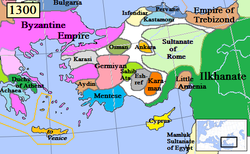Catalan Company
The Grand Catalan Company (Catalan: [Companyia Catalana d'Orient] Error: {{Lang}}: text has italic markup (help)), officially the Magna Societas Catalanorum, and widely known as the Catalan Company, was a free company of mercenaries founded by Roger de Flor in the early 14th century.
History
De Flor recruited soldiers left unemployed with the Peace of Caltabellotta in 1302 by the Crown of Aragon, who opposed the French dynasty of Anjou.
In 1303 de Flor offered the services of his Company to the Byzantine emperor Andronicus II Palaeologus and his son the Basileus Michael IX Palaeologus. The Orthodox Byzantine Empire was under threat by the Turks, who were invading Anatolia and established the mighty Sultanate of Rum, whose name expressed succeeding to the '[Eastern] Roman' empire.
Roger de Flor's offer was accepted by both Byzantium and by the Crown of Aragon, rulers in Sicily and southern Italy, who were quite eager to rid themselves of unemployed and unruly soldiers. Roger de Flor departed with 39 galleys and transports carrying around 1,500 knights and 4,000 Almogavars, special foot soldiers employed mainly serving the kingdom's interests in the Mediterranean Sea, especially from Catalonia, Valencia and Aragon.
Roger de Flor arrived in Constantinople with the help of king Frederick III of Sicily in 1303, and married the niece of Andronicus, daughter of the Tsar of Bulgaria, and was named Megas Doux ('Great Dux', i.e. head of the fleet). Roger de Flor campaigned with his Company in Anatolia, defeating the Turks but also engaging in widespread violence and looting of the Byzantine inhabitants. By this point, the Catalans, were considered by the Byzantines to be little better than brigands and freebooters.
End of Roger de Flor
This put him at odds with the Byzantine Emperor, and the indiscipline of the Almogavars marked the end of Roger de Flor. On 30 April 1305, he was slain along with 300 cavalry and 1,000 infantry by the Alans, another group of foreign mercenaries at the service of the Emperor.
The Company proceeded to devastate the Balkanic regions of Thrace and Macedonia for the next two years, including an attack on Thessalonica by land and sea, and raids against the monasteries on Mount Athos. Until recently no Catalans were allowed on the Athos peninsula by the Athonite monks.The struggle ended with the departure of both the Infante and Ferran, and with Bernat de Rocafort becoming leader of the Company.
Bernat de Rocafort offered the Company's services to Charles of Valois to strengthen his claim to the Byzantine Empire and whom the Count of Barcelona had expelled from Sicily before founding the Company in a dynastic war for the Crown of Aragon. In 1309, Charles of Valois' deputy Thibault de Chepoy ended the leadership of Rocafort, arresting him and sending him to Naples where he died of hunger the same year.
In 1318 the Company expanded its power into Thessaly, taking control of the Duchy of Neopatria.
End of the Company
The Catalan rule was to last until 1388–1390, when they were defeated by the Navarrese Company under Pedro de San Superano, Juan de Urtubia, and allied with the Florentines under Nerio I Acciaioli of Corinth. His descendants controlled them until 1456 when they were conquered by the Ottoman Empire. By that time, like many military enterprises, the Great Company had faded out of history.
Chronicle of muntaner
The early history of the Catalan Company was chronicled by Ramon Muntaner, a former member of the company, in his Crònica.
Sources and references
- Goodenough, Lady (1920). Chronicle of Muntaner. Hakluyt Society - Vol.1.
- Goodenough, Lady (1921). Chronicle of Muntaner. Hakluyt Society - Vol.2.
- Catalan Company (1302-1388 AD)
Catalan Company Media
Coat of arms of the Duchy of Neopatria
Archived 2009-02-08 at the Wayback Machine, by David Kuijt and Chris Brantley




